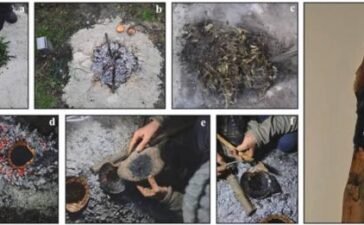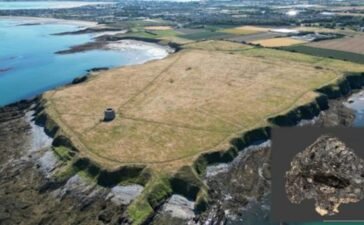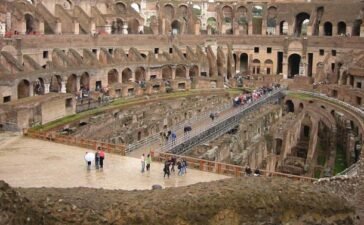For just the third time ever, an explorer has discovered the ruins of an ancient Roman fort in Wales. The broken and scattered remains of this nearly 2,000-year-old military structure were found hidden in an overgrown field in the seaside county of Pembrokeshire by Dr. Mark Merrony, a Roman scholar who teaches at Wolfson College, Oxford.
“It is a humongous fort, an incredible find of national importance,” Merrony told the Guardian, adding that he was “absolutely thrilled” about being responsible for such an amazing find.
The Oxford scholar believes the fort would have been constructed sometime between the first and third centuries AD, when the Roman Empire occupied the lands of the United Kingdom. It is the second Roman fort discovered in Pembrokeshire specifically, with the other having been excavated at Wiston near the municipality of Haverfordwest in 2013.
In addition to finding the remains of the fort, Merrony was also able to verify that a road running beside it was Roman in origin. He was able to do this because the road actually connects the fort in the field with the second one located at Wiston.
Taken together, the existence of the two forts shows that the Romans had a robust military presence in the region in ancient times. This is contrary to expectations, since it has long been thought that the Celtic Demetae tribe that lived in Wales 2,000 years ago had gotten along well with the Romans and hadn’t presented any real threat. But the existence of a network of forts seems to show that this wasn’t the case.
“I now don’t think they [the Demetae tribe] were pro-Roman at all, but that the Romans were hitting the area with an iron fist,” Merrony stated.

Example of a Roman fort ruins: Aerial of Hardknott Roman Fort is an archeological site, the remains of the Roman fort Mediobogdum,, Cumbria, England. (jmh-photography/Adobe Stock)
A Treasure of Ruins Hidden in Plain Site
A native of Pembrokeshire, Dr. Merrony often travels along the road that runs by the field where the fort is located. Because of how straight the road is, he had frequently wondered whether it had originally been built by the Romans, and that piqued his curiosity about the area in general.
He recently examined satellite imagery of the area, looking for ruins, and in one particular field he noticed an outline of what he thought might have been a Roman fort. This was not visible through the brush that covered the field when standing at ground level, but quite clear when viewed from above.
Shortly thereafter, Merrony went out to take a closer look at the field, and while fighting through the thickets he stumbled across something most revealing.
“Sticking out of the ground was a triangular piece that looked like a Roman roofing slate,” he said. “I thought: ‘Surely not?’ I pulled it up and lo and behold, it’s an archetypal Roman roofing slate, an absolute peach. Flip it upside down and you can see underneath a diagonal line where it was grooved to fit into the one that was underneath it. It’s a real beauty.”

Roman roofing slate found in the Pembrokeshire field investigated by Merrony. (Roman Fort Project)
After finishing a brief survey of the field, he went to talk to the farmer to whom the land belonged. He told the farmer about his discovery of the roofing piece, and the farmer told him that there was slate and stone buried just beneath the earth all around the site (which is why the field was unplowed and essentially abandoned).
“That suggests there’s a lot of material under the ground,” Merrony said. “That’s because there’s obviously several collapsed buildings here. The slates are left, the timbers have rotted.”
Further surface level examinations have led to the discovery of more roofing slate pieces, which are covered in streaks of rust from decayed nails and feature marks that show the pieces had been chiseled and attached to other slate tiles.
“These are diagnostically consistent with other slates from Romano-British buildings,” Merrony confirmed.
Tracing the outline of the fort, Merrony believes it would have covered between 5-7.5 acres (2-3 hectares) of land when it was standing. He estimates that the fort would have been large enough to support a deployment of about 500 Roman soldiers, meaning it would likely have functioned as an auxiliary fort rather than as a main point of defense.
Another Success for Pembrokeshire’s Leading Roman Archaeologist
This unique archaeological discovery wasn’t the first one that put Dr. Mark Merrony’s name in the headlines. In 2002 he found the remains of a Roman villa in Pembrokeshire, and ever since then he has been searching on his own for other signs of Roman occupation in his home county.
He did discover a previously undetected Roman road running alongside the Preseli Hills region of western Wales in 2022, but finding the rare fort is undoubtedly his greatest achievement as an archaeologist so far.
“There are more villas than we think and there are more forts than we think,” he proclaimed in an interview with the BBC. “In west Wales, I wouldn’t be surprised if there were at least another two, three or more forts that we just haven’t found yet. West Wales has been neglected, partly because there aren’t the resources to cover it. So the more archaeologists start looking, the more you start to find.”
At the present time, Merrony is not disclosing the exact location of the newly discovered fort, to make sure it is protected from vandals, looters, and curiosity seekers. To thoroughly evaluate the site a geophysical survey will need to be performed, which will require the intervention of regional archaeological trusts that have the resources to sponsor this type of comprehensive study.
Top image: An artist’s impression of the fort. Source: Roman Fort Project
By Nathan Falde






